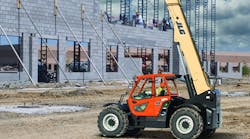Forty-two states and the District of Columbia added construction jobs between May 2017 and May 2018, while 28 states added construction jobs between April and May, according to an analysis by the Associated General Contractors of America of Labor Department data released today. Association officials warned that soaring construction costs, aggravated by new tariffs on steel and aluminum, could trigger project cancellations and job losses.
"It is heartening to see such widespread construction job gains," said chief economist Ken Simonson. "However, unexpected, steep cost increases for many materials may force some contractors to lay off workers, while passing on price hikes will likely cause public agencies and private owners to delay or cancel projects."
California added the most construction jobs (50,000 jobs, 6.2 percent) during the past year. Other states adding a large number of new construction jobs for the past 12 months include Texas (43,100 jobs, 6.1 percent); Florida (31,300 jobs, 6.2 percent); Georgia (15,300 jobs, 8.4 percent), Arizona (12,600 jobs, 8.8 percent) and Michigan (12,500 jobs, 7.7 percent). West Virginia added the highest percentage of new construction jobs during the past year (11.1 percent, 3,400 jobs), followed by Arizona, Georgia, Michigan and Utah (7.6 percent, 7,300 jobs). Construction employment reached a record high in Louisiana, Nebraska and Texas.
Only six states shed construction jobs between May 2017 and May 2018, while construction employment was unchanged in Montana and Wyoming. New Jersey lost the most jobs (-4,600 jobs, -3.0 percent), followed by North Dakota (-1,800 jobs, -6.4 percent); Missouri (-1,500 jobs, -1.2 percent) and South Carolina (-1,400 jobs, -1.4 percent). In addition, Kentucky and Iowa each lost 100 jobs (-0.1 percent). North Dakota had the largest percentage loss of construction jobs over the year, followed by New Jersey, South Carolina, Missouri, Kentucky and Iowa.
Of the 28 states that added construction jobs between April and May, Ohio added the most (6,000 jobs, 2.7 percent), followed by Texas (5,800 jobs, 0.8 percent); New York (3,000 jobs, 0.8 percent); Michigan (2,700 jobs, 1.6 percent) and Louisiana (2,300 jobs, 1.6 percent). North Dakota added the highest percentage of construction jobs for the month (8.5 percent, 2,100 jobs), followed by South Dakota (4.3 percent, 1,000 jobs); Nebraska (3.7 percent, 1,900 jobs); Maine (3.2 percent, 900 jobs) and Rhode Island (3.2 percent, 600 jobs).
Sixteen states and D.C. lost construction jobs from April to May, while construction employment was unchanged in Delaware, Missouri, New Mexico, Utah, Virginia, and Wisconsin. The largest number construction job losses in May—2,900—occurred in California (-0.3 percent) and New Jersey (-1.9 percent), followed by 1,200 jobs lost in Nevada (-1.3 percent) and Kentucky (-1.6 percent). Wyoming lost the highest percentage of construction jobs for the month (-2.0 percent, -400 jobs), followed by New Jersey, Kentucky and Nevada.
Association officials said that rising costs for many construction materials are likely to undermine future employment growth in the sector. They noted that contractors will have a hard time passing the additional costs along to their clients, leaving less money available to invest in new personnel or equipment. And they urged administration officials to reconsider imposing new tariffs that are likely to undermine economic growth.
"Construction employment in many parts of the country could be impacted as firms get caught in the crossfire of the looming trade war," said Stephen E. Sandherr, the association's CEO.










